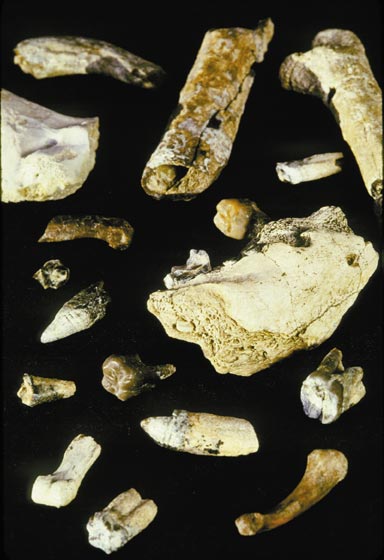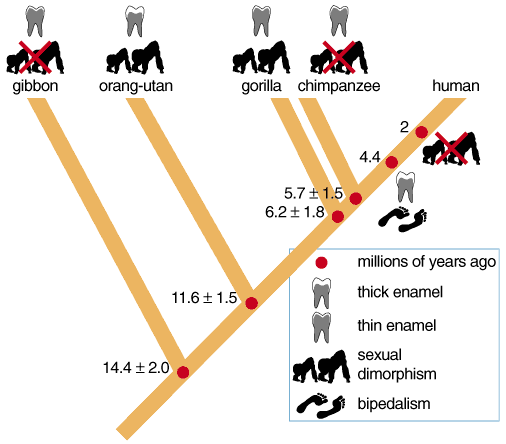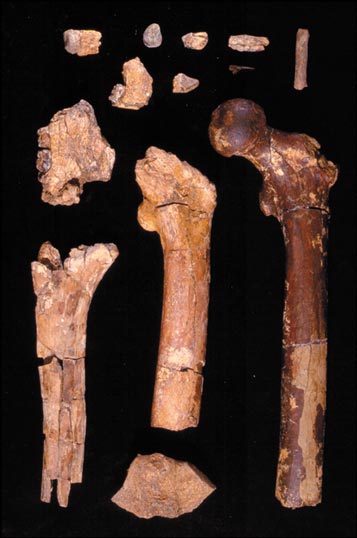Hunting the First Hominid
By Pat Lee Shipman
Can we really hope to trace the evolutionary origin of hominids?
Can we really hope to trace the evolutionary origin of hominids?

DOI: 10.1511/2002.13.25
Self-centeredly, human beings have always taken an exceptional interest in their origins. Each discovery of a new species of hominid—both our human ancestors and the near-relatives arising after the split from the gorilla-chimp lineage—is reported with great fanfare, even though the First Hominid remains elusive. We hope that, when our earliest ancestor is finally captured, it will reveal the fundamental adaptations that make us us.
There is no shortage of ideas about the essential nature of the human species and the basic adaptations of our kind. Some say hominids are fundamentally thinkers; others favor tool-makers or talkers; still others argue that hunting, scavenging or bipedal walking made hominids special. Knowing what the First Hominid looked like would add some meat to a soup flavored with speculation and prejudice.
Genetic and molecular studies provide one sort of insight, showing what sort of stuff we are made of, and that it is only slightly different stuff from that which makes up the apes (gorillas, chimps, orang-utans and gibbons). From the molecular differences among the genes of humans and apes, geneticists estimate the time when each of the various ape and hominid lineages diverged from the common stem. The result is a sort of hairy Y diagram, with multiple branches instead of simply two as is usual on a Y. Each terminus represents a living species; each branching point or node represents the appearance of some new evolutionary trait, such as new molecules, new genes, new shapes or new proportions of limb, skull and tooth. Unfortunately, this way of diagramming the results tends to lull us into thinking (falsely) that all the evolutionary changes occurred at those nodes, and none along the branches.
Such studies omit a crucial part of our history: the extinct species. Only the fossil record contains evidence, in context, of the precise pathway that evolution took. In this technological age, when sophisticated instrumentation and gee-whiz algorithms seem downright necessary, the most basic information about the evolution of our lineage still comes from branches of science that operate in rather old-fashioned ways. The primary discoveries in paleontology (the study of old things), paleoanthropology (the study of old humans) and archaeology (the study of the old stuff that old humans leave around) still rely on the efforts of a handful of investigators who slog around on foot or excavate in desolate landscapes. Fancy equipment can't replace eyes and brains, although instrumentation plays a crucial role in the dating and analysis of fossil remains.
Finding the evolutionary origin of hominids is a little like stalking big game. Paleoanthropologists struggle to establish when and where their quarry was last seen and what it was like—hoping to follow its tracks backward in time. (Why hominids or any other group arose is such a metaphysical question that most paleoanthropologists run away screaming when it is asked.)
When the first hominid slinked through the underbush has been estimated from molecular clocks and confirmed by radiometric dates. These lines of evidence converge on a period between 5 million and 7 million years ago as the time when a primitive, perhaps vaguely apelike species evolved some definitive new adaptation that transformed it into the First Hominid. But like the point of inflection on a line graph, the first species in any new lineage is only readily apparent after the fact. The emergence of the first hominid was probably not obvious in prospect but only now, in retrospect—in the context of the entire evolutionary record of the hominids—when the long-term evolutionary trends can be seen.
Where this dangerous creature once lived has to be Africa, since both our closest living relatives (chimpanzees and gorillas) and all early hominids (older than about 2 million years ago) are African.
What happened, exactly, and to whom, remain to be discovered. Two newly discovered fossil species have each been proposed to be the First Hominid. This circumstance raises a significant issue: How would we know the First Hominid if we saw it?
Making a list of key features that differentiate apes from people is not difficult, but misleading. It is absurd to expect that all of these differences arose simultaneously during a single evolutionary event represented by the final fork on the hairy Y diagram. The first ape on the gorilla-chimp lineage was neither a gorilla nor a chimpanzee, for modern gorillas and chimps have had at least 5 million years to evolve in isolation before arriving at their modern form. In the same way, the First Hominid on our lineage was not a human and did not possess all of the characteristics of modern humans.

Using a hairy Y diagram, we can limit the number of contenders for the essential or basal hominid adaptation:
—Hominids might be essentially bipeds. All known hominids are bipedal; no apes are.
—Wishful thinking aside, hominids are not simply brainy apes. Alas, until about 2 million years ago no hominid had a brain larger than an ape's relative to its body size.
—Hominids might be apelike creatures that have lost their sexual dimorphism. Sexual dimorphism is exhibited as male-female differences that are not related to reproduction. For example, male orangs are typically much larger than females and have longer canine teeth that hone sharper with wear. The fossil record shows that hominids lost their dental sexual dimorphism first, since all known hominids have small and flat-wearing canines. In contrast, sexual dimorphism in body size persisted in hominids until about 2 million years ago, when the genus Homo first appeared.
—Thick dental enamel may be a key hominid trait. All hominids have thick enamel, whereas all fossil and living apes (except those in the orang-utan lineage) have thin enamel. Because the fossil record of apes is so poor, we do not know whether the primitive condition for apes and hominids was thick or thin enamel. Indeed, how enamel thickness is to be measured and evaluated has generated many pages of debate.
—Hominids are hand-graspers or manipulators (from the Latin for hand, manus), whereas apes are foot-graspers. These differences are reflected in the sharp contrasts in the hand and foot anatomy of apes and humans. Apes have divergent big toes and long, curved toe bones for holding onto branches; their thumbs are short and cannot be opposed to the other fingers for skillful manipulation. Human beings are the opposite, with long, opposable thumbs and big toes that are closely aligned with the remaining short, straight toes. Human feet are nearly useless for grasping but are well adapted to bipedalism. An intermediate condition occurs in early hominids such as Lucy (the best-known individual of Australopithecus afarensis), who had opposable thumbs and numerous adaptations to bipedalism, and yet retained rather long and curved toes. Lucy and probably other types of Australopithecus were walkers, hand-graspers and somewhat compromised foot-graspers.
A description of our desired prey, then, might read like this:
An ape-brained and small-canined creature, with dental enamel of unknown thickness. Large if male but smaller if female. May be spotted climbing adeptly in trees or walking bipedally on the ground. Last seen in Africa between 5 million and 7 million years ago.
From this description, can we identify the First Hominid? Well, no—not yet.
Yohannes Haile-Selassie of the University of California, Berkeley, described a likely contender from Ethiopia in July of 2001. His material comes from Ethiopian sediments between 5.2 million and 5.8 million years old and is called Ardipithecus ramidus kadabba, a new subspecies. Ardipithecus means "root ape" in the Afar language, and the species has been explicitly proposed to be a "root species" ancestral to all later hominids.
Haile-Selassie's specimens include more than 20 teeth, some associated with a mandible or lower jaw; substantial pieces of two left humeri, or upper arm bones; a partial ulna from the same forearm as one humerus; a partial clavicle or collarbone; a half of one finger bone; and a complete toe bone.
No ironclad evidence of bipedality in any Ardipithecus specimen has yet been published. In this collection, the only evidence about habitual patterns of locomotion comes from the single toe bone. Its weight-bearing surface faces downward as in bipeds, not inward as in apes. Any jury might be suspicious that Ardipithecus was bipedal, but none of the really telltale body parts—pelvis, complete femur, tibia, or ankle bones—has yet been recovered. The preserved bones of the arm, finger and shoulder closely resemble those of Lucy and may have been used in grasping and tree-climbing. Ardipithecus is as yet too poorly known for its relative brain size or sexual dimorphism in body size to be assessed.

The other candidate that has already been bagged is a 6 million-year-old find from the Tugen Hills of Kenya called Orrorin tugenensis. Its generic name is derived from the Tugen language and means "original man"—a claim as bold as "root ape." Found by a joint French-Kenyan team headed by Brigitte Senut of the Centre nationale de la recherche scientifique, the Orrorin fossils include a few teeth, some embedded in a jaw fragment; a partial humerus; a finger bone; and substantial parts of three femurs, or thigh bones.
The femurs, which might provide definitive evidence of bipedality, are incomplete. The sole evidence for bipedality lies in the head of the femur in Orrorin, which is proportionately larger than Lucy's. One reason to evolve a large-headed femur is to dissipate the forces produced by bipedalism. The team concludes that Orrorin evolved bipedalism separately from Lucy (and from other species of Australopithecus), making Orrorin the only known ancestor of Homo. Australopithecus is displaced to an extinct side-branch of the hominid lineage.
Their surprising conclusion is not universally accepted. Skeptics reply that the femoral differences between Orrorin and Australopithecus might disappear if Orrorin's femur were compared with that of a large male individual rather than with the diminutive Lucy.
As in Ardipithecus, the bones from the upper limb of Orrorin show tree-climbing adaptations. Neither relative brain size nor body size dimorphism can be evaluated in Orrorin.
Where Orrorin and Ardipithecus differ are in their teeth. Orrorin appears to have thick enamel, like a hominid or an orang-utan, and Ardipithecus seems to have thin enamel, like other apes. This dental comparison might resolve the question "Who is the First Hominid?" in favor of Orrorin, except that Orrorin's canine teeth imply the opposite conclusion. Orrorin's single known canine is sizable and pointed and wears like an ape's canine. In contrast, the several known canines of Ardipithecus are all small-crowned and flat-wearing, like a hominid's canines.

Puzzlingly, Ardipithecus and Orrorin show different mosaics of hominid and ape features. Both may be bipeds, although Ardipithecus is a biped in the manner of Australopithecus and Orrorin is not. If one of these two newly announced species is the First Hominid, then the other must be banished to the ape lineage. The situation is deliciously complex and confusing.
It is also humbling. We thought we knew an ape from a person; we thought we could even identify a man in an ape suit or an ape in a tuxedo for what they were. Humans have long prided themselves on being very different from apes—but pride goeth before a fall. In this case, embarrassingly, we can't tell the ape from the hominid even though we have teeth, jaws, and arm and leg bones.
Paleoanthropologists must seriously reconsider the defining attributes of apes and hominids while we wait for new fossils. In the meantime, we should ponder our complicity, too, for we have been guilty of expecting evolution to be much simpler than it ever is.
© Pat Shipman
Click "American Scientist" to access home page
American Scientist Comments and Discussion
To discuss our articles or comment on them, please share them and tag American Scientist on social media platforms. Here are links to our profiles on Twitter, Facebook, and LinkedIn.
If we re-share your post, we will moderate comments/discussion following our comments policy.